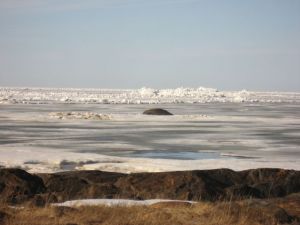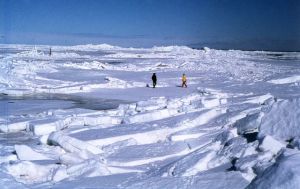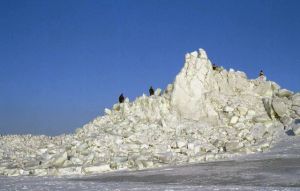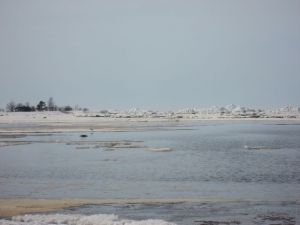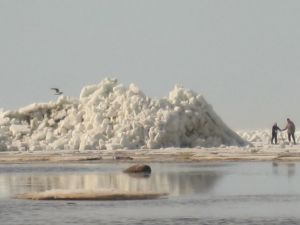Pack ice and bad engineering
Serious threats to the world’s first arctic nuclear power plant
The Fennovoima company was founded by E.On (Germany) and stainless steel producer Outokumpu (Finland) to become the third nuclear energy company in Finland. Outokumpu is a very power-hungry company, using about 300 megawatts of electricity 24/7. E.On has problems with it’s own nuclear reactors reaching end of life in Germany. Other members of this company are small industries and utility companies in Finland. The company business idea is called “Mankala-principle”, which allows the company to avoid all taxes when selling power to its shareholders. This kind of operation was twice questioned in Finland during the 1960’s, and is currently under examination of the EU commission as a violation to the directives.
Being a new player in the field, Fennovoima started its first reactor project with no engineering staff. There are no experienced reactor design engineers in Europe, as the last reactor by E.On started production in the 1980’s. Finland’s current reactors are 1970’s design, from USSR and Sweden. Because of Chernobyl accident, no new NPP projects were started in Europe until the troublesome Olkiluoto and Flamanville projets, both seriously behind their schedules and over budget.
Because of this lack of knowledge, the Fennovoima chose their alternative plant sites from the worst possible places. The main criteria for locations is employment: select small villages with high unemployment rates. The cooling system requirements or power grid requirements were not assessed at all. In February 2010 the national grid company Fingrid[1] stated: “the location will be on the wrong side of the bottleneck between the north and south, and the grid capacity can not be strengthened enough, if large amount of wind power is constructed in northern Sweden”. A week later the Swedish wind power company, Markbygdens vind, announced a project of 4 GW wind farm near Piteå,[2] About 150 km west of the Fennovoima NPP site in Pyhäjoki. Conclusion: there is no power grid strong enough to carry this 1.6 GW production to south, 500 km away to consumers[3]. Northern Finland is already 107% self-sufficient with electricity because of it’s large hydropower capacity[4].
Even bigger design failure comes from the shallow water at the sites. Two professors, Canadian Gordon Edwards (Canada) and Alfred Körblein (Germany), visited the Simo site in 2010, and wondered how the cooling of the plant can be secured in this kind of location. 1.6 GW NPP generates about 4.5 GW of heat, and because of the poor efficiency of boiling water reactors, 2/3 of this energy must be dumped in the sea. During summer, the shallow water heats very fast, and when the cooling water temperature rises enough, the efficiency of the plant drops, and in some cases, the plant must be completely stopped because the condensation of steam becomes impossible. A deep water supply is not an option, as the shallow water continues several kilometers from the shore before reaching 10 meters depth. During winter, the cooling water melts the ice near the output side of the plant. When the water cools to +4 degrees, it sinks to the bottom, but in a shallow area this warm water weakens the solid ice from beneath.
The gulf of Bothnia is an arctic sea. It freezes completely during the winter[5], and the thickness of the ice usually reaches 1 meter. During strong winds, the central part, called drift ice, moves quite fast, sometimes 20 kilometers a day[6]. The sailors report: “the ice movement can be seen by plain eye, as the icebreaker moves, the path it created closes in behind”. When this ice reaches the shore, it is packed into huge walls. These pack ice walls can reach 10 meters high and usually stand firmly on the bottom. Near Pyhäjoki, the locals have given it a name “röysit”, so it’s not very rare thing to happen.[7]
Conclusion: a power plant with 60 to 90 cubic meters / second water intake cannot survive the pack ice of the gulf of Bothnia. Pack ice walls can happen anytime during the winter. They melt away in may-june[8], so during this time the plant cannot operate at full power because of lack of cooling water. Pack ice is porous[9], 70% of ice and 30% of water has been measured in some places, but if the waterflow through this wall is high enough, the turbulences inside the wall can slow down the flow. If the wall builds very close to the water intake, it prevents even the emergency cooling intake which is several cubic meters /second. So there is a similar scenario as in Fukushima, without an earthquake or tsunami, only a strong south-western wind during winter is needed. Any precautions, emergency power supplies and diesel generators cannot help: if there is no water available, there is no cooling. It can happen only once.
Matti Adolfsen, Kemi
- (Pyhäjoki location on this map is in half- way between Kalajoki and Pikkarala)
Finnish versions of this article were published in Helsingin Sanomat 3.4.2011 and in “Voima” magazine 28.4.2011. Pictures: Vuokko Moisala (Pyhäjoki) and Anna-Kaarina Kairamo (Simo). Updated 8.5.2011
- ↑ http://www.geni.org/globalenergy/library/national_energy_grid/finland/index.shtml
- ↑ http://www.sweden.gov.se/sb/d/12858/a/140825
- ↑ http://vattenkraft.info/index.php?page=teori/stamnat
- ↑ http://www.lapinliitto.fi/c/document_library/get_file?folderId=53864&name=DLFE-3202.pdf, p.20
- ↑ http://upload.wikimedia.org/wikipedia/commons/f/f1/Scandinavia_M2002074_lrg.jpg
- ↑ http://www.itameriportaali.fi/en/tietoa/jaa/en_GB/millaista_jaata_esiintyy/
- ↑ http://www.raahenseutu.fi/cs/Satellite/Uutiset/1194675707162/artikkeli/mahtavat%20roysit.html
- ↑ Captain Paavo Isola, Helsingin Sanomat 12.4.2011
- ↑ Professor Mauri Määttänen, Helsingin Sanomat 7.4.2011
